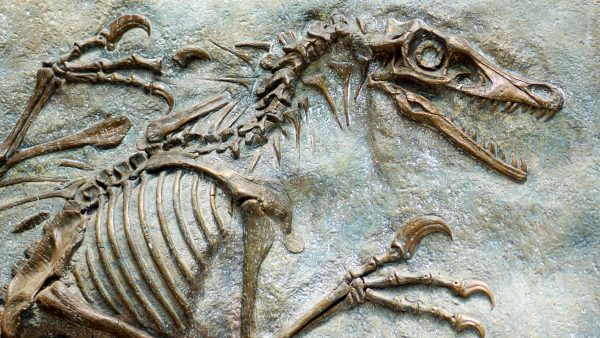Trace Fossil Definition
A trace fossil is an impression or other preserved sign of ancient organism activity, not its remains. For example, feeding, scratching, burrowing, walking, or resting.
View Lesson on The Fossil Record
Become a member to get full access to our entire library of learning videos, reading material, quiz games, simple DIY activities & more.
Become a member to get full access to our entire library of learning videos, quiz games, & more.
Plans & Pricingto watch this full video.

Access All Videos
and Lessons, No Limits.
Access All Videos

No credit card required,
takes 7 sec to signup.
No card required

Ready-to-go lessons
that save you time.
Ready-to-go lessons
If you are on a school computer or network, ask your tech person to whitelist these URLs:
*.wistia.com, fast.wistia.com, fast.wistia.net, embedwistia-a.akamaihd.net
Sometimes a simple refresh solves this issue. If you need further help, contact us.
The Fossil Record
Fun Facts
- Trace fossils include footprints, burrows, and even fossilized poop!
- Trace fossils can be molds and casts.
- Trace fossils tell about an organism's activity while alive.
Why Do We Need To Know About Trace Fossil
Learning about trace fossils helps us know more about what life and environments were like a long time ago. Trace fossils, like footprints or holes made by animals, show us how these ancient creatures lived and behaved.
This knowledge is important for jobs in paleontology, where scientists study these fossils to learn about how life on Earth has changed over time. It also helps people who work in museums and in teaching others about Earth’s history. By studying trace fossils, we get important information that helps us share the story of life on Earth with others.
Frequently Asked Questions
Check out the Full Lesson on The Fossil Record
In this lesson, we learn that:
- Fossils are evidence of past life, such as bones, teeth, and footprints.
- The collection of fossils in the Earth's crust and their placement in chronological order is called the fossil record.
- Scientists study the fossil record to understand how life on Earth has changed over time.
Related Topics
- Amplitude Definition
- Bioindicator Definition
- Biotechnology Definition
- Body Fossils Definition
- Cast Fossils Definition
- Cell Definition
- Cellular Respiration Definition
- Chemical Change Definition
- Conduction Definition
- Convergent Boundary Definition
- Ecosphere Definition
- Electromagnetic Radiation Definition
- Electromagnetic Spectrum Definition
- Fossil Definition
- Fossil Record Definition
- Gas Definition
- Generator Definition
- Geologic Processes Definition
- Humidity Definition
- Hydrosphere Definition
- Insulator Definition
- Light Source Definition
- Magnetic Poles Definition
- Matter Definition
- Metamorphosis Definition
- Mold Fossils Definition
- Mutualism Definition
- Nucleus Definition
- Organelle Definition
- Paleontologist Definition
- Parasitism Definition
- Pattern Definition
- Plant Growth Definition
- Pollution Definition
- Precipitation Definition
- Rain Definition
- Rain Gauge Definition
- Reversible Change Definition
- Seed Dispersal Definition
- Senses Definition
- Solution Definition
- Sound Definition
- Total Eclipse Definition
- Trace Fossil Definition
- Tsunami Definition
- Wave Reflection Definition
- Weather Definition
- Wind Erosion Definition
Start a Free Trial Today. Get a $5 Amazon Gift Card!
Teachers! Start a free trial & we'll send your gift card within 1 day. Only cards left. Try it now.
Select Grade
Select Subject
This email is associated with a Science Kit subscription. Kit subscriptions are managed on this separate page: Manage Subscription

-
Download InvoiceScience & Math$/yr
-
Download InvoiceScience Only$/yr

access all lessons
• No credit card required •
"My students loved the videos. I started the video subscription in May and used them as a review before the state test, which I know contributed to 100% of my class passing the state test."
Rhonda Fox 4th Grade Teacher, Ocala, Florida
Use Generation Genius in Your School
Access all lessons free for 30 days.
"My students loved the videos. I started the video subscription in May and used them as a review before the state test, which I know contributed to 100% of my class passing the state test."
Rhonda Fox 4th Grade Teacher, Ocala, Florida
• No credit card required •
Already a member? Sign In
* no credit card required *

* no credit card required *
* no credit card required *


to Discover the Benefits of Generation Genius
Learn How to Save for Your School & District!

no credit card required
Skip, I will use a 3 day free trial
Enjoy your free 30 days trial
-
Unlimited access to our full library
of videos & lessons for grades K-5. -
You won’t be billed unless you keep your
account open past your 14-day free trial. -
You can cancel anytime in 1 click on the
manage account page or by emailing us.
-
Unlimited access to our full library of videos & lessons for grades K-5.
-
You won't be billed unless you keep your account open past 14 days.
-
You can cancel anytime in 1-click on the manage account page.
Cancel anytime in 1-click on the manage account page before the trial ends and you won't be charged.
Otherwise you will pay just $10 CAD/month for the service as long as your account is open.
Cancel anytime on the manage account page in 1-click and you won't be charged.
Otherwise you will pay $10 CAD/month for the service as long as your account is open.
We just sent you a confirmation email. Enjoy!
DoneWe use cookies to make your experience with this site better. By using this site you agree to our use of cookies. Click "Decline" to delete and block any non-essential cookies for this site on this specific property, device, and browser. Please read our privacy policy for more information on the cookies we use.Learn More
We use cookies to improve your experience. By using this site, you agree to our use of cookies. Click "Decline" to block non-essential cookies. See our privacy policy for details.Learn More




























































































































